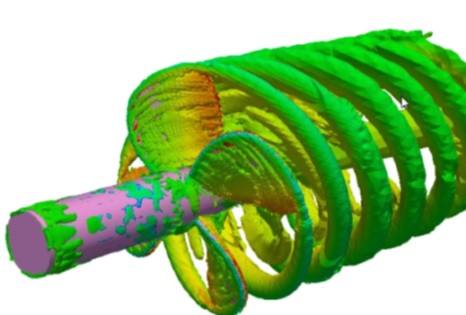OpenFOAM® CFD Aeroacoustics

This course covers Theoretical and Applied concepts in Computational Aeroacoustics (CAA) using OpenFOAM, touching on progressive Multiphysics design challenges, e.g. Aero-Vibro-acoustics (AVA). In the practical part of the course, we will see how to use acoustic analogy, how to prepare and set up the case to resolve the air-born sound. Post-processing leading to noise characteristics is explained and tested.
An experienced trainer from OpenCFD – the company delivering official distribution of OpenFOAM every 6 months - will be presenting practical training based on the latest release. Training is based on mixture of lectures and hands-on exploring simple applications run on a cloud computer. More information can be found at https://openfoam.com/training/aerospace.php
LEARNING OBJECTIVES
- Understand spatial and temporal considerations (mesh and time-step)
- Noise Propagation to the far-field using acoustics analogies, e.g. Curle
- Understand the boundary condition choices and application of the damping zone
- Learn to operate spectral postprocessing using the built-in OpenFOAM point-based and surface-based temporal-Fourier analysis tools
- General hints and best practices to the CAA application with OpenFOAM
AUDIENCE
The Aeroacoustics course is suitable for existing users of OpenFOAM seeking to broaden their knowledge of OpenFOAM in the area of ACC. The Course is designed to impart important background knowledge to be able to use OpenFOAM effectively. The aim of the training is not only to show how to use OpenFOAM but as well to explain how it works to help users understand the choices they make on meshing, numerics and boundary condition setup with respect to the desired results.
Type of Course: Instructor-Led Short Course
Course Length: 1 day
AIAA CEU's available: Yes
DETAILED OUTLINE
- Basics - aeroacoustics source and propagation mechanisms, including a shallow dive into classical theory
- Narrowband (tonal) and broadband flow noise
- Spatial and Temporal considerations (mesh and time-step)
- Turbulence and wall-modelling
- Steady-state: fast approximations of source mechanisms and ratings
- Surface based (shear-flow correlation)
- Volume based (Lilley-Proudman correlation)
- Transient:
- Appropriate physics modelling and boundary conditions for aeroacoustics
- Numerical control settings in OpenFOAM
- Pure acoustics in OpenFOAM test.
- Spectral postprocessing using the built-in OpenFOAM point-based and surface-based temporal-Fourier analysis tools
- Noise Propagation to the far-field using acoustics analogies, e.g. Curle
- General hints and tips
- Insights into coupling with Acoustic propagation codes for acoustics and vibroacoustics using SEA, FEA and BEM.
- Acoustic damping of spurious CFD mechanisms
- Mesh-frequency cut-off
- Fan/propeller noise sources
- Wavenumber-frequency analysis, including free-access to a test license of the AVA module in VA One
- Separation of turbulent flow and acoustic aeroacoustics sources mechanisms
Course Delivery and Materials
- Access to the software and individual logins will be provided through cloud computing.
- All slides and exercises will be available for download.
- No part of these materials may be reproduced, distributed, or transmitted, unless for course participants. All rights reserved.
- Sessions will not be recorded.
Matej Forman, leads the OpenFOAM training team, is based in Europe working as part of the core OpenFOAM team at OpenCFD for the past 7 years, and has worked with OpenFOAM for the past 12 years. His academic background is in combustion, heat/mass transfer and multiphase flows. In addition to his lead training responsibilities, Matej develops documentation and training materials for meshing best practices, physical modeling and numerical controls.
AIAA Training Links
For information, group discounts,
and private course pricing, contact:
Lisa Le, Education Specialist (lisal@aiaa.org)
